|
|||
|
|
|
|
|
TALLER LAS CHICAS KODAK 20.01.2020 - 21.01.2020 La Trasera UCM, Madrid |
||
|---|---|---|---|
 |
|||
| [ES]
El taller se reflexiona a cerca de la figura de la "Kodak Girl" como objeto publicitario y a la vez como la primera vez que la mujer irrumpe en la fotografía y genera comunidad entre mujeres con los álbumes de recortes que creaban. Propone hacer en común diversos fanzines, enseñar técnicas de encuadernación caseras y continuar con esa práctica que caracteriza esta generación de mujeres. Partiendo de una documentación previa para la introducción a esta historia y practica artística no tan común. El ejercicio fotográfico como punto de partida para ahondar en el imaginario personal y así poder conocer de aquellos recursos artísticos de los que dispondremos para la realización del álbum. Imparten y coordinan: |
[ENG] The workshop reflects on the figure of the "Kodak Girl" as an advertising object and at the same time as the first time that women break into photography and generate community among women with the scrapbooks they created. The purpose is to make various fanzines in common, teach homemade binding techniques and continue with that practice that characterizes this generation of women. Starting from a previous documentation for the introduction to this history and artistic practice not so common. The photographic exercise as a starting point to delve into the personal imagination and thus be able to know about those artistic resources that we will have for the making of the album.
|
||
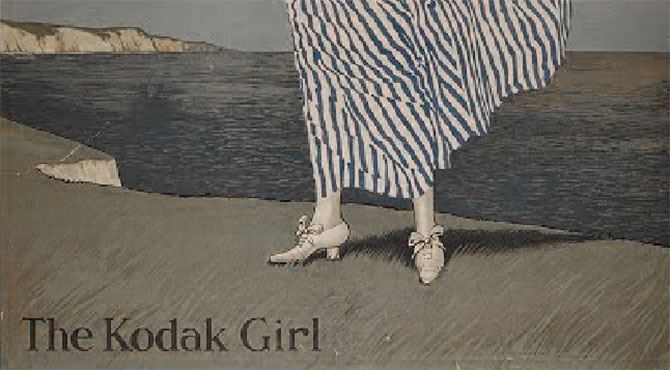 |
|||
La icónica chica Kodak, con su vestido a rayas azules y blancas, se convirtió en sinónimo de los productos Kodak. Es una imagen que es familiar para muchos: la mujer romántica y elegante, en una playa barrida por el viento, sosteniendo su cámara Kodak. |
|||
PROGRAMA / PROGRAM |
|
||
| Sesión 2: [ES] La segunda sesión siendo completamente práctica se centra en la creación y aplicación de los conceptos aprendidos siguiendo los movimientos propios de cada participante y la posterior puesta en común del ejercicio, generar esa comunidad que tiene como unión la investigación en la apropiación de imágen. |
Session 2: [ENG]The second session, being completely practical, focuses on the creation and application of the concepts learned following the movements of each participant and the subsequent sharing of the exercise, generating that community whose union is research on image appropriation. |
||
 |
|||
 |
|||
Mujeres El nuevo arte de la fotografía[ES] En 1893 comenzó a aparecer en fotografías publicitarias la Kodak Girl, un personaje que encarnaba la independencia y los viajes. Esta representación de la mujer independiente en el inicio de la era progresista fue parte de una estrategia de marketing. En este momento Kodak puso en el mercado la primera cámara con película fotográfica en rollo. Esta película se enrollaba en un mecanismo de carretes acoplado en una caja, la conocida Kodak no.1. Estas cámaras se enviaban al fabricante para su revelado y recarga. La fotografía era accesible para todos. El mensaje de que esta cámara era tan fácil de usar que incluso una mujer podía manejarla pero no fue condescendiente. Hacia el cambio de siglo, las mujeres se volvieron más autosuficientes y de sentirse libres para salir y explorar el mundo. Desde vacaciones en la playa hasta salidas invernales nevadas y partidos de tenis, la mujer moderna era amante de la diversión e independiente. El producto Kodak empujó los límites de The New Woman aventureras, independientes e inteligentes, y en busca de la próxima gran fotografía. Algunas viajaron por el mundo para encontrarlo. Pero esta no era la única imagen de la Chica Kodak, otras encontraron los grandes momentos en sus propios hogares. Las mujeres que quisieron ser madres y esposas responsables, debían asegurarse de capturar los momentos preciosos de la vida de sus hijos: todo debía registrarse y guardarse para la posteridad. Las mujeres eran consideradas las guardianas de la memoria de la familia. Esta estrategia de marketing resultó tan lucrativa que el tema continuó en los anuncios durante muchos años. Durante siglos, las mujeres han sido las narradoras de la vida doméstica en volúmenes conocidos como álbumes de recortes, scrapbooks. Su creación es un método para conservar, presentar y organizar la historia personal y familiar. Los recuerdos típicos incluyen fotografías, medios impresos y dibujos. Con frecuencia contienen entradas de diario extensas o descripciones escritas. Combinando el análisis textual feminista con una mirada etnográfica es una forma de producción de conocimiento colectiva de las mujeres. Una forma de arte que incorpora historias y experiencias femeninas para preservar un sentido de sí mismas y al mismo tiempo expresar públicamente sus inquietudes y preocupaciones. Los álbumes de amistad y los anuarios escolares de los siglos XVIII y XIX ofreció a las mujeres un medio para compartir sus habilidades literarias y de documentar su propio registro histórico personalizado. A principios de siglo XIX las universitarias utilizaron ampliamente los álbumes de recortes para construir representaciones de su vida cotidiana. Se consideraban una forma más sofisticada de preservar las propias experiencias que llevar un diario u otras formas de registro basadas en la escritura. Sin fotografías para proporcionar imágenes, se crearon representaciones únicas a través de recortes, objetos efímeros y recuerdos. Una página de estos álbumes de recortes puede incluir horarios de clases, folletos de exámenes, cartas de profesores u otro material impreso. Una lista de invitados o tarjetas de visita pueden representar una fiesta. Un cartel y una entrada pueden servir como recordatorio de un viaje o un espectáculo. El nacimiento de la fotografía moderna permitió incorporar fotografías en sus álbumes de recortes. Scrapbooking combina elementos visuales y narrativos, demuestran técnicas para manejar los recuerdos culturales reformulando su autoimagen más como activistas del cambio social que entusiastas que participan en una afición trivial. El propio acto de cortar las fotografías era una forma de desarticular o cuestionar el contexto social en el que vivían. Las teorías feministas apuntan que la mayoría de las autobiografías están escritas por hombres. Al buscar escritos e información sobre mujeres, se encontró una fuente enorme de otro tipo de escritos autobiográficos que habían sido excluidos de la definición tradicional de autobiografía: cartas, diarios y scrapbooks. El diario es un “género feminista profundamente femenino”, una “práctica feminista” por su multiplicidad de modos, su unión a la comunidad y la colectividad, su cotidianidad, poniendo el foco en lo personal. Los álbumes de recortes como forma de autobiografía, como los diarios, traspasan los límites de los documentos públicos y privados. Por lo general, no se consideran documentos públicos. El ámbito privado siempre ha sido el ámbito de la mujer, y el hecho de que se haga público y se considere y critique públicamente es una transgresión de fronteras. Como mujer, contar tu historia es un acto radical. Si se examinan las estrategias narrativas y retóricas empleadas en los álbumes de recortes, se observa cómo las mujeres a través de la narración, reclaman una voz pública sobre la experiencia femenina. Debido a que el álbum de recortes se ha conservado mal y ha sido muy poco estudiado, el curso propone la tarea de analizar las páginas del álbum de recortes, sobre todo, crear conciencia sobre el álbum de recortes como un artefacto y reindicar un lenguaje cultural relevante que contiene ricas narrativas contextuales del yo y la sociedad. |
Women The new art of photography [ENG] In 1893, the Kodak Girl, a character who embodied independence and travel, began to appear in publicity photographs. This representation of the independent woman in the beginning of the progressive era was part of a marketing strategy. At this time, Kodak put the first camera with roll photographic film on the market. This film was wound on a reel mechanism attached to a box, the well-known Kodak No. 1. These cameras were sent to the manufacturer for development and reloading. Photography was accessible to everyone. The message that this camera was so easy to use that even a woman could handle it but was not condescending. Towards the turn of the century, women became more self-reliant and free to go out and explore the world. From beach vacations to snowy winter outings and tennis matches, the modern woman was fun-loving and independent. The Kodak product pushed the boundaries of The New Woman adventurous, independent and intelligent, and in search of the next great photography. Some traveled the world to find it. But this was not the only image of the Kodak Girl, others found the great moments in their own homes. Women who wanted to be responsible mothers and wives had to make sure they captured the precious moments in their children's lives: everything had to be recorded and saved for posterity. Women were considered the guardians of the family's memory. This marketing strategy proved so lucrative that the theme continued in advertisements for many years. For centuries, women have been the narrators of domestic life in volumes known as scrapbooks. Its creation is a method of preserving, presenting and organizing personal and family history. Typical souvenirs include photographs, print media, and drawings. They often contain long journal entries or written descriptions. Combining feminist textual analysis with an ethnographic look is a form of collective knowledge production of women. An art form that incorporates feminine stories and experiences to preserve a sense of self while publicly expressing concerns and concerns. Friendship albums and school yearbooks from the 18th and 19th centuries offered women a means to share their literary skills and to document their own personalized historical record. At the beginning of the 19th century, female university students used scrapbooks extensively to construct representations of their daily lives. They were seen as a more sophisticated way of preserving one's experiences than journaling or other forms of writing-based recording. Without photographs to provide images, unique renderings were created through cutouts, ephemeral objects, and keepsakes. A page of these scrapbooks can include class schedules, test booklets, letters from teachers, or other printed material. A guest list or business cards can represent a party. A poster and a ticket can serve as a reminder of a trip or a show. The birth of modern photography allowed you to incorporate photos into your scrapbooks. Scrapbooking combines visual and narrative elements, demonstrating techniques for managing cultural memories by reframing your self-image more as social change activists than enthusiasts engaged in a trivial hobby. The very act of cutting the photographs was a way of dismantling or questioning the social context in which they lived. Feminist theories suggest that most autobiographies are written by men. Searching for writings and information about women, she found a huge source of other types of autobiographical writing that had been excluded from the traditional definition of autobiography: letters, diaries and scrapbooks. The newspaper is a "deeply feminine feminist gender", a "feminist practice" due to its multiplicity of ways, its union with the community and the collectivity, its daily life, putting the focus on the personal. Scrapbooks as a form of autobiography, like diaries, go beyond the limits of public and private documents. These are generally not considered public documents. The private sphere has always been the sphere of women, and the fact that it is made public and publicly considered and criticized is a transgression of borders. As a woman, telling your story is a radical act. If the narrative and rhetorical strategies used in scrapbooking are examined, it is observed how women, through narration, claim a public voice over the female experience. Because the scrapbook has been poorly preserved and has been very little studied, the course proposes the task of analyzing the pages of the scrapbook, above all, raising awareness of the scrapbook as an artifact and re-indicating a cultural language. Relevant containing rich contextual narratives of self and society. |
||
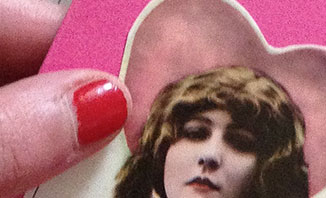 |
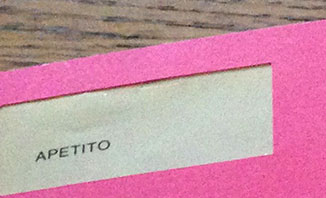 |
||
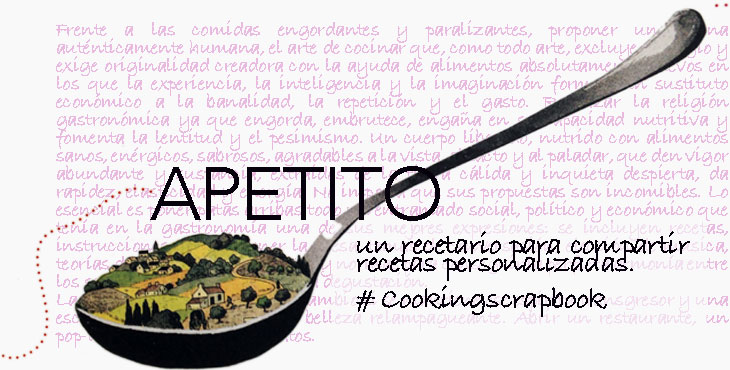 |
|||
| #Partituras #Eventscores for everyday happenings | |||
 |
|||
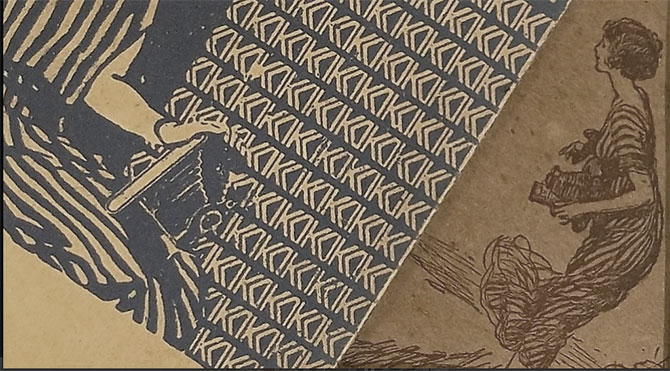 |
|||
LAS CHICAS KODAK |
|||
|
|||